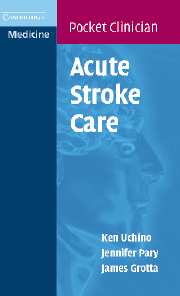Book contents
- Frontmatter
- Contents
- Preface
- List of abbreviations
- 1 Stroke in the emergency department
- 2 What to do first
- 3 Ischemic stroke
- 4 TPA protocol
- 5 Neurological deterioration in acute ischemic stroke
- 6 Ischemic stroke prevention: why we do the things we do
- 7 Transient ischemic attack (TIA)
- 8 Intracerebral hemorrhage (ICH)
- 9 Subarachnoid hemorrhage (SAH)
- 10 Organization of stroke care
- 11 Rehabilitation
- Appendix 1 Numbers and calculations
- Appendix 2 IV TPA dosing chart
- Appendix 3 Sample admission orders
- Appendix 4 Sample discharge summary
- Appendix 5 Stroke radiology
- Appendix 6 Transcranial Doppler ultrasound (TCD)
- Appendix 7 Heparin protocol
- Appendix 8 Insulin protocol
- Appendix 9 Medical complications
- Appendix 10 Brainstem syndromes
- Appendix 11 Cerebral arterial anatomy
- Appendix 12 Stroke in the young and less common stroke diagnoses
- Appendix 13 Brain death criteria
- Appendix 14 Neurological scales
- Recommended reading
- References
5 - Neurological deterioration in acute ischemic stroke
Published online by Cambridge University Press: 10 October 2009
- Frontmatter
- Contents
- Preface
- List of abbreviations
- 1 Stroke in the emergency department
- 2 What to do first
- 3 Ischemic stroke
- 4 TPA protocol
- 5 Neurological deterioration in acute ischemic stroke
- 6 Ischemic stroke prevention: why we do the things we do
- 7 Transient ischemic attack (TIA)
- 8 Intracerebral hemorrhage (ICH)
- 9 Subarachnoid hemorrhage (SAH)
- 10 Organization of stroke care
- 11 Rehabilitation
- Appendix 1 Numbers and calculations
- Appendix 2 IV TPA dosing chart
- Appendix 3 Sample admission orders
- Appendix 4 Sample discharge summary
- Appendix 5 Stroke radiology
- Appendix 6 Transcranial Doppler ultrasound (TCD)
- Appendix 7 Heparin protocol
- Appendix 8 Insulin protocol
- Appendix 9 Medical complications
- Appendix 10 Brainstem syndromes
- Appendix 11 Cerebral arterial anatomy
- Appendix 12 Stroke in the young and less common stroke diagnoses
- Appendix 13 Brain death criteria
- Appendix 14 Neurological scales
- Recommended reading
- References
Summary
Although classically stroke symptoms are maximal at onset and patients gradually recover over days, weeks, and months, patients can deteriorate. People have termed the phenomenon stroke progression, stroke in evolution, stroke deterioration, and symptom fluctuation. There is no consistent terminology. The phenomenon occurs from different causes and is incompletely understood. This chapter will discuss evaluation of potential causes, and approaches for treatment of each cause.
Probable causes
Stroke enlargement (e.g., arterial stenosis or occlusion with worsening perfusion).
Drop in perfusion pressure.
Recurrent stroke (not common).
Cerebral edema and mass effect.
Hemorrhagic transformation.
Metabolic disturbance (decreased O2 saturation, decreased cardiac output, increased glucose, decreased sodium, fever, sedative drugs, etc.).
Seizure, post-ictal.
Symptom fluctuation without good cause (due to inflammation?).
The patient is not feeling like cooperating (sleepy, drugs).
Initial evaluation of patients with neurologic deterioration
Check airway–breathing–circulation, vital signs, laboratory tests. Is the patient hypotensive or hypoxic?
Talk to and examine the patient. If the patient is sleepy, is it because it's 3 a.m. or because of mass effect? Is there a pattern of symptoms (global worsening vs. focal worsening)?
Get an immediate non-contrast head CT (to evaluate for hemorrhage, new stroke, swelling, etc.).
Review medications (antihypertensives, sedatives).
Observe patient, and ask nurse, for subtle signs of seizure.
Consider MRI for arterial imaging, new stroke, stroke enlargement, swelling; TCD or CT angiography for arterial imaging; EEG to diagnose subclinical seizures.
Stroke enlargement
This occurs when there is arterial stenosis or occlusion and the hemodynamics change for whatever reason.
- Type
- Chapter
- Information
- Acute Stroke CareA Manual from the University of Texas - Houston Stroke Team, pp. 48 - 60Publisher: Cambridge University PressPrint publication year: 2007



